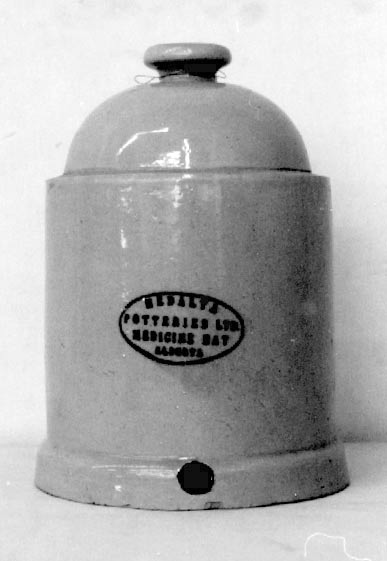Brief Historical Overview
We will limit our examination of Medalta’s markings to those used between 1916 and 1954, or in other words to those used by the firms producing pottery under the names of Medalta Stoneware Limited or Medalta Potteries Limited. The original builder and occupier of the factory produced pottery under an altogether different name, The Medicine Hat Pottery Company Limited, as did the firms that occupied the plant after Medalta Potteries Limited went bankrupt in 1954. One of these, occupying the plant in 1958, produced pottery under a similar name, New Medalta Ceramics, while the other used the name Sunburst Ceramics Limited
The reason for treating Medalta Stoneware and Medalta Potteries together is that the plant changed hands in 1924 with little or no interruption of production, with the new plant taking over and using the moulds of the earlier plant. Both of these potteries relied upon their stoneware line of products - crocks, jugs, churns, bowls, etc. - and to a lesser extent their lines of earthenware pitchers and bowls, until Medalta Potteries Limited hired Tom Hulme to head-up its art department in 1929. While stonewares remained a mainstay, the plant introduced many new lines, particularly vases, jardinieres and lamps. In addition, its business in producing specialty named products, bearing the names of hotels and merchants and where they were located, expanded quite rapidly to peak around 1937 or 1938.
In 1937 Medalta hired a young ceramic engineer, Ed Phillipson, who took over as plant superintendent. He set Medalta on its new path, bringing it into the “hotel age”. It was Mr. Phillipson who determined that the white burning clays located at Willows, Saskatchewan, were suitable for making a hard burning product. Over the next few years, Medalta developed its line of hotel china and by 1940 it was all but complete including a full line of service wares from plates, soup and salad bowls, through to pitchers and creamers.
Hotelwares carried Medalta through the war years and into the early fifties. Stonewares were still as popular as ever, although the range in sizes and variety had been reduced to some extent. Artwares were also available but again, it seems, not in the wide assortment that was produced before the war. It was the hotelwares that dominated Medalta’s production. Its sturdy, thick-walled, heavy-duty restaurant china1 was in high demand throughout Canada and probably would have carried the plant for quite a few more years; but, alas, new owners acquired the Medalta plant in 1952 and directed that it be retrofitted for the production of a new lighter ware.
Hotelwares carried Medalta through the war years and into the early fifties. Stonewares were still as popular as ever, although the range in sizes and variety had been reduced to some extent. Artwares were also available but again, it seems, not in the wide assortment that was produced before the war. It was the hotelwares that dominated Medalta’s production. Its sturdy, thick-walled, heavy-duty restaurant china1 was in high demand throughout Canada and probably would have carried the plant for quite a few more years; but, alas, new owners acquired the Medalta plant in 1952 and directed that it be retrofitted for the production of a new lighter ware.
The new owners envisioned making their fortune by producing millions of items for the movie theatre giveaway market. Pay your admission and with it, you would get a plate this week and a salad bowl next week, until you had built up a complete set. It was a good idea, but one that was ten years too late. Just as Medalta was ready to go into full production, the demand fell. Televisions were becoming cheap enough for every home to own one, so why go out to the theatre so often? In 1954 Medalta fired its last kiln load, closing its doors, and with it losing an important part of southern Alberta’s industry
The aspects of this brief history that are important to the study of Medalta’s stamps are the change in name in 1924 and the introduction of its hotel china line. All products that are marked with one of the stamps that say “Medalta Stoneware Ltd.” date to 1924 or earlier; the ones reading “Medalta Potteries Limited” date from 1924 to 1954. Most, but not all, of the stamps that just include the name Medalta in the stamp are ones used by the later company. The introduction of Medalta’s hotel china is important as many of the stamps include the term “hotel china” and thereby are dated to 1937 or later.
Copyright rongetty.com, All Rights Reserved
Login - 216.73.216.26

